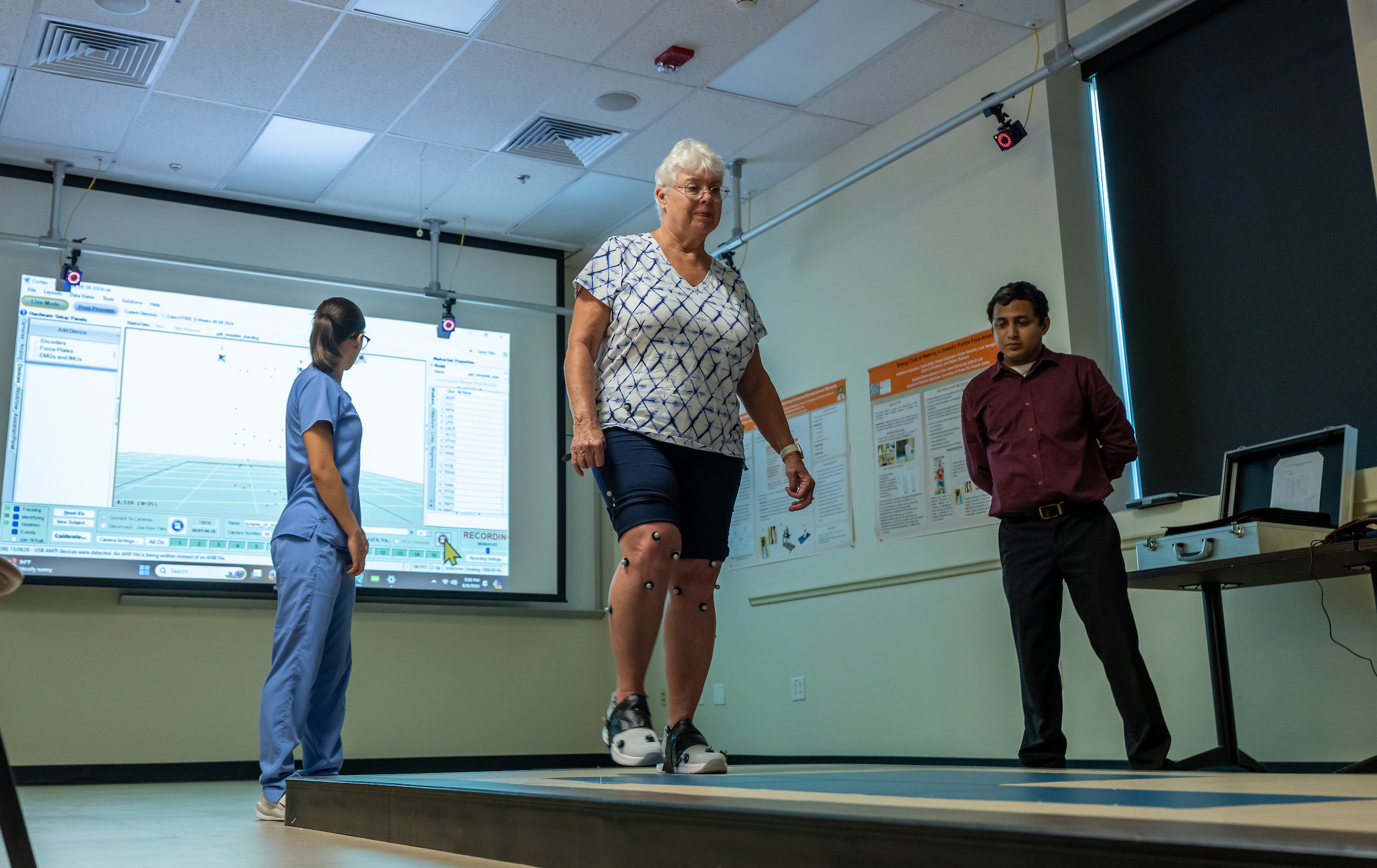- April 5, 2025
UTRGV School of Podiatric Medicine establishes hi-tech motion-capture biomechanics lab

Capturing motion to improve mobility
By Karen Villarreal
RIO GRANDE VALLEY, TX – There’s more to gait, or the pattern of walking, than meets the eye. The UTRGV School of Podiatric Medicine (SOPM) has established a 16-camera studio-style lab to capture the data behind each step.
The motion-capture system, featuring a ceiling-mounted multi-camera array and reflective marker sensors, utilizes the same technology used by movie studios and video game developers for CGI modeling.
However, Dr. Hafizur Rahman, assistant professor of Medicine at SOPM and director of the new Applied Biomechanics of the Lower Extremity (ABLE) Laboratory, is not creating games or films. He and his students use this technology to study gait biomechanics and improve treatment for patients with foot and ankle deformities.
The lab conducts detailed studies to help podiatrists measure how well patients respond to non-invasive treatments, such as physical therapy, braces or shoe inserts.
“Patients with foot and ankle deformities have affected gait. There is not much quantitative data, and a lack of understanding, on how gait or walking pattern will improve after treatment,” Rahman said.
Dr. Javier La Fontaine, dean of the UTRGV School of Podiatric Medicine, said that the lab is an important tool to provide better care for patients with foot dysfunctions.
“It’s important to understand how the human body functions during motion,” he said. “Most of the problems that we get on the foot and ankle manifest from the systemic aspect of how we walk.”
IT RELATES TO GAIT
Imbalanced gait and compromised walking performance can lead to severe consequences, from foot pain and fall injuries to various health challenges associated with a sedentary lifestyle.
Diabetes and associated complications, like cardiovascular disease, heart attack and stroke, are a particular concern for podiatrists in the Rio Grande Valley, where a large patient population has advanced stages of diabetes and a high incidence of lower extremity amputations.
Rahman stresses the importance of prevention and addressing the root causes of leg and foot pain early to help patients maintain mobility.
He notes that patients with foot pain often place excessive pressure on specific areas of the foot, commonly the ball of the heel.
“Pain reduces as the pressure becomes more uniformly distributed by conservative treatments, such as shoe gear and orthotics, which eventually help prevent foot ulceration and ulcer recurrence,” Rahman explained.
Supportive devices can prevent concentrated pressure points from forming diabetic foot ulcerations, corns and calluses, which can lead to deformities that further impact gait and mobility.
“With the lab’s tools, we can verify from a quantitative perspective how much these treatments are lowering the pressure and pain on the patient’s feet,” he said.
Based on this understanding, Rahman and his team are developing innovative footwear to improve walking performance in patients with foot and ankle deformities.
ONGOING RESEARCH PROJECTS
La Fontaine and Dr. Luis Venegas, clinical collaborators of the ABLE lab, recruit patients based on the inclusion and exclusion criteria of the research projects.
The following student researchers are currently working with Rahman in the ABLE lab:
- Krista Elizabeth Samreth, a second-year podiatric medicine student, is measuring dynamic in-shoe plantar pressure distribution to determine the effectiveness of therapeutic shoes and prefabricated inserts in reducing foot pain and peak pressure in patients with foot pain.
- Elnaaz Eskandari, a second-year podiatric medicine student, is comparing plantar pressure and gait characteristics in patients with hammertoe deformities before and after various treatments.
- Karishma Sebastian, a second-year podiatric medicine student, is using advanced biomechanical tools to quantify metabolic energy expenditure (cardiac function and oxygen consumption) in diabetic patients with different levels of partial-foot amputation and resulting gait changes.
- Anthony Melgar, a master’s student in Biomedical Engineering, is utilizing musculoskeletal modeling and simulation tools to study lower extremity muscle functions in patients with partial foot amputations.
- Marissa Silva, undergraduate Biology student, and Sabrina Winkler, an undergraduate Exercise Science student, are collaborating on developing specific footwear to improve walking performance for patients who have undergone toe amputations.
For more information about the UTRGV School of Podiatric Medicine, visit www.utrgv.edu/school-of-podiatric-medicine.

